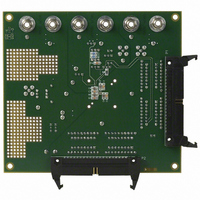AD9755-EB Analog Devices Inc, AD9755-EB Datasheet - Page 10

AD9755-EB
Manufacturer Part Number
AD9755-EB
Description
BOARD EVAL FOR AD9755
Manufacturer
Analog Devices Inc
Series
TxDAC+®r
Datasheet
1.AD9755ASTZ.pdf
(28 pages)
Specifications of AD9755-EB
Rohs Status
RoHS non-compliant
Number Of Dac's
1
Number Of Bits
14
Outputs And Type
1, Differential
Sampling Rate (per Second)
300M
Data Interface
Parallel
Settling Time
11ns
Dac Type
Current
Voltage Supply Source
Analog and Digital
Operating Temperature
-40°C ~ 85°C
Utilized Ic / Part
AD9755
AD9755
FUNCTIONAL DESCRIPTION
Figure 3 shows a simplified block diagram of the AD9755. The
AD9755 consists of a PMOS current source array capable of
providing up to 20 mA of full-scale current, I
divided into 31 equal sources that make up the five most significant
bits (MSBs). The next four bits, or middle bits, consist of 15 equal
current sources whose value is 1/16th of an MSB current source.
The remaining LSBs are a binary weighted fraction of the middle
bit current sources. Implementing the middle and lower bits
with current sources, instead of an R-2R ladder, enhances dynamic
performance for multitone or low amplitude signals and helps
maintain the DAC’s high output impedance (i.e., >100 kΩ).
All of the current sources are switched to one or the other of the
two outputs (i.e., I
switches. The switches are based on a new architecture that
significantly improves distortion performance. This new switch
architecture reduces various timing errors and provides matching
complementary drive signals to the inputs of the differential
current switches.
The analog and digital sections of the AD9755 have separate
power supply inputs (i.e., AVDD and DVDD) that can operate
independently over a 3.0 V to 3.6 V range. The digital section,
which is capable of operating at a 300 MSPS clock rate, consists
of edge-triggered latches and segment decoding logic circuitry.
The analog section includes the PMOS current sources, the
associated differential switches, a 1.20 V band gap voltage
reference, and a reference control amplifier.
The full-scale output current is regulated by the reference
control amplifier and can be set from 2 mA to 20 mA via an
external resistor, R
with both the reference control amplifier and voltage reference
V
segmented current sources with the proper scaling factor. The
full-scale current, I
REFIO
, sets the reference current I
0.1 F
R
2k
OUTA
SET
OUTFS
SET
. The external resistor, in combination
or I
, is 32 times the value of I
REFIO
FSADJ
DCOM
OUTB
1.2V REF
ACOM
) via PMOS differential current
AD9755
REF
3.0V TO 3.6V
DVDD
, which is replicated to the
PMOS CURRENT
SOURCE ARRAY
AVDD
OUTFS
PORT 1 LATCH
Figure 3. Simplified Block Diagram
DB0 – DB13
REF
. The array is
DIGITAL DATA INPUTS
.
SWITCHES FOR
DB0 TO DB13
SEGMENTED
DAC LATCH
2 –1 MUX
PORT 2 LATCH
DB0 – DB13
–10–
DAC
REFERENCE OPERATION
The AD9755 contains an internal 1.20 V band gap reference.
This can easily be overdriven by an external reference with no
effect on performance. REFIO serves as either an input or output,
depending on whether the internal or an external reference is used.
To use the internal reference, simply decouple the REFIO
pin to ACOM with a 0.1 µF capacitor. The internal reference
voltage will be present at REFIO. If the voltage at REFIO is
to be used elsewhere in the circuit, an external buffer amplifier
with an input bias current less than 100 nA should be used. An
example of the use of the internal reference is given in Figure 4.
A low impedance external reference can be applied to REFIO, as
shown in Figure 5. The external reference may provide either a
fixed reference voltage to enhance accuracy and drift performance
or a varying reference voltage for gain control. Note that the 0.1 µF
compensation capacitor is not required since the internal reference
is overdriven, and the relatively high input impedance of REFIO
minimizes any loading of the external reference.
REFERENCE CONTROL AMPLIFIER
The AD9755 also contains an internal control amplifier that is
used to regulate the DAC’s full-scale output current, I
The control amplifier is configured as a voltage-to-current con-
verter as shown in Figure 4, so that its current output, I
determined by the ratio of V
as stated in Equation 4. I
sources with the proper scaling factor to set I
Equation 3.
The control amplifier allows a wide (10:1) adjustment span of
I
62.5 µA and 625 µA. The wide adjustment span of I
several application benefits. The first benefit relates directly to
the power dissipation of the AD9755, which is proportional to
I
benefit relates to the 20 dB adjustment, which is useful for sys-
tem gain control purposes.
The small signal bandwidth of the reference control amplifier is
approximately 500 kHz and can be used for low frequency, small
signal multiplying applications.
OUTFS
OUTFS
DIV0
over a 2 mA to 20 mA range by setting I
(refer to the Power Dissipation section). The second
CIRCUITRY
DIV1
PLL
PLLLOCK
I
I
PLLVDD
CLKVDD
CLK+
CLK–
CLKCOM
RESET
LPF
OUTA
OUTB
REF
REFIO
is applied to the segmented current
V
DIFF
= V
and an external resistor, R
OUT
R
50
V
OUT
LOAD
A – V
B
OUT
OUTFS
B
R
50
V
OUT
LOAD
REF
OUTFS
, as stated in
A
between
REF
provides
REV. B
OUTFS
, is
SET
.
,












